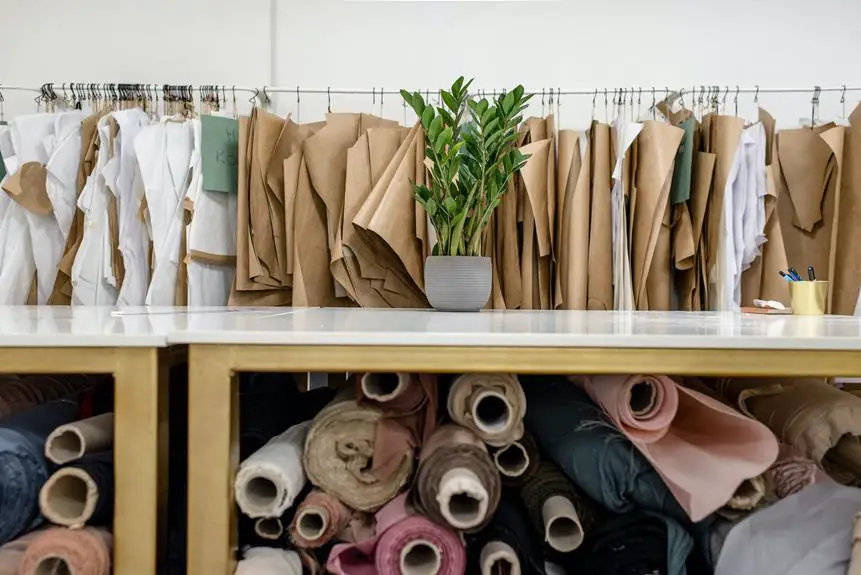Do you ever wonder how a raincoat manages to keep you dry even in the heaviest downpour? It's all thanks to the magic of fabric PU.
PU, or polyurethane, is a synthetic material that is applied to fabrics to enhance their performance. In simple terms, fabric PU involves coating the fabric with a thin layer of polyurethane, which provides excellent water resistance and durability. This process creates a barrier that repels water and prevents it from seeping through the fabric.
Understanding fabric PU opens up a world of possibilities for creating waterproof and long-lasting clothing, bags, and outdoor gear. Let's dive deeper into the fascinating world of fabric PU and discover its many benefits and applications.
Key Takeaways
- Fabric PU is a synthetic material known for its excellent water resistance and durability.
- It creates a barrier that repels water and prevents it from seeping through the fabric.
- Fabric PU is widely used in outdoor garments, bags, and footwear.
- The PU coating process involves applying a layer of polyurethane to fabric, which enhances durability and extends the lifespan of products.
The Basics of Fabric PU
Understanding the basics of fabric PU involves considering its properties and applications in various industries.
Fabric PU, or polyurethane, is a versatile material widely used in the textile industry for its remarkable properties. It's known for its durability, flexibility, and water-resistant qualities, making it an ideal choice for outdoor garments, bags, and footwear.
The use of fabric PU has revolutionized waterproofing technology, providing a breathable yet water-resistant layer for outdoor gear.
In the textile industry, fabric PU is also used to create synthetic leather, offering a sustainable alternative to genuine leather. This hasn't only reduced the reliance on animal products but has also provided a more eco-friendly option for various goods.
Its material properties make it a preferred choice for manufacturers looking to create durable, high-quality products.
Understanding the applications and benefits of fabric PU in the textile industry is crucial for those seeking to master the art of material selection and product development.
PU Coating Process Explained
The PU coating process involves applying a layer of polyurethane to fabric, enhancing its durability and water resistance. This process is essential for creating high-quality outdoor gear, rainwear, and other products requiring water resistance.
| PU Coating Process | Explained |
|---|---|
| Step 1 | *Preparation* |
| The fabric is cleaned and prepared for coating. Any imperfections or contaminants are removed to ensure a smooth application. | |
| Step 2 | *Coating Application* |
| Polyurethane is applied to the fabric using various methods such as spraying, dipping, or roller coating. This ensures even coverage and penetration of the fabric fibers. | |
| Step 3 | *Curing and Inspection* |
| The coated fabric is cured at the appropriate temperature to ensure the polyurethane bonds effectively. It is then inspected for quality and uniformity. |
The PU coating process not only enhances fabric durability but also provides excellent water resistance. By following these steps, manufacturers can create durable, weather-resistant products that meet the high standards of outdoor enthusiasts and professionals.
Advantages of Fabric PU
Fabric PU offers enhanced durability and water resistance. The PU coating provides a protective layer that makes the fabric more resistant to wear and tear, increasing its lifespan. This means your items made with fabric PU will withstand daily use and maintain their quality over time, saving you money in the long run.
Additionally, the water resistance of fabric PU ensures that your belongings remain dry and protected in wet conditions. Whether it's a bag, jacket, or umbrella, fabric PU helps repel water, keeping the contents safe from moisture damage. This advantage makes fabric PU especially valuable for outdoor and sportswear, where exposure to the elements is common.
The combination of durability and water resistance makes fabric PU an excellent choice for various products, offering reliability and performance. When you choose items made with fabric PU, you can have confidence in their ability to endure frequent use and adverse weather conditions, providing you with peace of mind and long-lasting satisfaction.
Common Applications of PU Fabric
You'll find PU fabric used in a wide range of products, including clothing, upholstery, and accessories. Its versatility and durability make it a popular choice for various applications.
Here are some common uses of PU fabric:
- PU Fabric in Fashion Industry: PU fabric is widely used in the fashion industry for creating stylish and affordable clothing and accessories. It's often used as a leather alternative, offering a cruelty-free option for consumers who are conscious about animal welfare. PU fabric can be found in jackets, skirts, handbags, shoes, and other fashion items.
- PU Fabric in Automotive Upholstery: In the automotive industry, PU fabric is commonly used for upholstery in vehicles. Its ability to mimic the look and feel of genuine leather makes it a preferred choice for car seats, steering wheel covers, and interior trims. Additionally, PU fabric offers easy maintenance and is resistant to wear and tear, making it ideal for automotive applications.
The versatility and adaptability of PU fabric have made it an essential material in both the fashion and automotive industries. Its wide range of applications continues to showcase the practicality and aesthetic appeal of this synthetic material.
Understanding PU Fabric Care and Maintenance
To properly care for and maintain PU fabric, it's essential to follow specific cleaning and storage guidelines to prolong its lifespan and preserve its appearance. PU fabric is known for its durability, but proper care is still crucial to maintain its quality. Here are some cleaning techniques, stain prevention, and storage tips to help you keep your PU fabric in top condition.
| Cleaning Techniques | Durability |
|---|---|
| Use mild soap and water to clean PU fabric. Avoid harsh chemicals. | PU fabric is durable and can withstand regular cleaning without losing its quality. |
| Stain Prevention | Storage Tips |
| Wipe spills immediately with a clean, damp cloth to prevent stains. | When storing PU fabric items, keep them in a cool, dry place away from direct sunlight to prevent discoloration and cracking. |
Following these guidelines will help you maintain the appearance and longevity of your PU fabric items, ensuring that they remain in excellent condition for years to come.
Frequently Asked Questions
What Are the Environmental Impacts of Using Fabric Pu?
When using fabric PU, consider the environmental impacts. The manufacturing processes can have sustainability implications. Be mindful of the resources used and waste produced. Look for ways to minimize the ecological footprint of fabric PU production.
Can Fabric PU Be Recycled or Biodegraded?
When it comes to fabric PU, recycling options are limited due to the complexity of the material. However, in some cases, it can be biodegraded through a process that breaks down the polyurethane components.
Are There Any Health Concerns Associated With Using Fabric Pu?
Using fabric PU may pose health risks due to potential chemical exposure. It's important to consider any associated health concerns before using fabric PU to ensure your safety and well-being.
How Does the Cost of Fabric PU Compare to Other Types of Fabric Coatings?
When comparing fabric PU to other coatings, cost varies based on quality and brand. Durability assessment reveals fabric PU to be cost-effective long-term. Consider your specific needs and budget when making a decision.
What Are the Limitations or Drawbacks of Using Fabric Pu?
When using fabric PU, consider its limitations and drawbacks. It offers durability and easy maintenance but may lack breathability and can deteriorate over time. Regular care and proper storage can help mitigate these issues.
- Tetron Fabric Price in the Philippines: A Detailed Look - June 17, 2025
- Tetron Fabric Price Guide: What to Expect - June 17, 2025
- Where to Buy Tetron Fabric: Top Retailers and Online Stores - June 17, 2025





